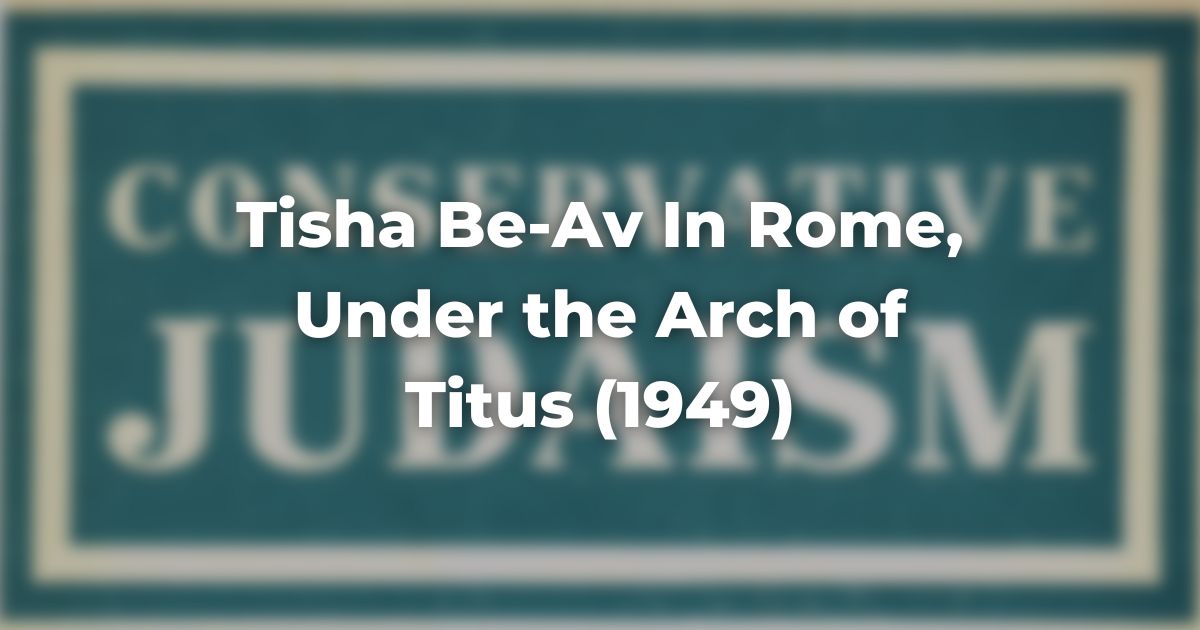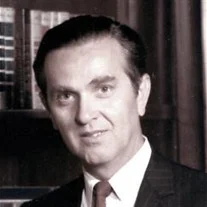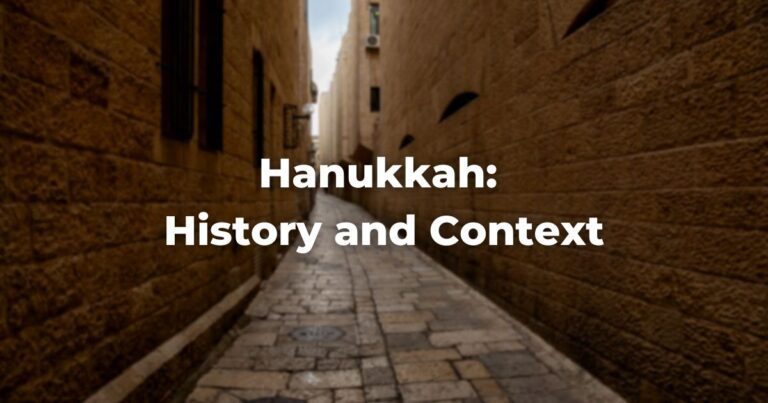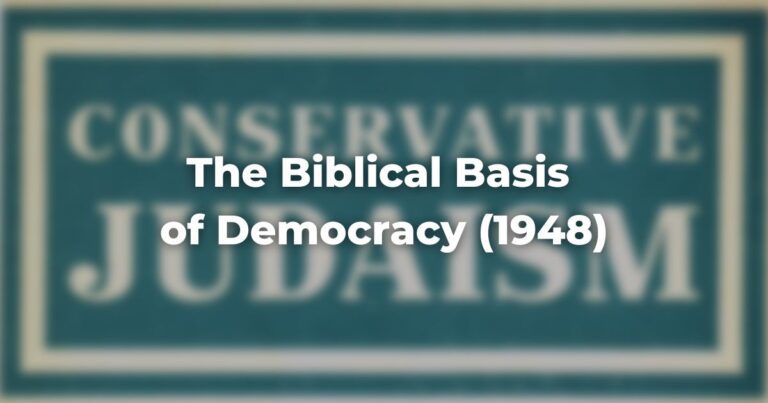This article was published in the Conservative Judaism academic journal, a publication of the Conservative Movement that ran from 1945-2014 that reflected the some of the many voices of the movement, and was recently relaunched as Masorti Journal.
This piece was written by Rabbi Meyer Abramowitz z”l in in 1948. The language and style may reflect the time it was written.
The piece has been reformatted for readability and edited for length. The full article with footnotes is available for those who wish to read it. Headings added by the editor.
Tisha Be-Av In Rome, Under the Arch of Titus (1948)
The phrase Tish’a be-Av amid the ruins of the Roman Empire in itself seems to be fraught with inner meaning and significance. It becomes ever so much more dramatic when one actually feels this experience, as we did during the Fast of Tish’a be-Av, in the summer of 1948.
Our presence at these ruins in the afternoon of Shabat Hazon was accidental rather than planned. All week, our hearts and mind were depressed at the plight of the Jewish refugees in Italy wasting away in DP camps. Most of them continued their bleak existence with only the hope of getting to Palestine buoying up their spirits. Others, anxious to be united with their families, daily knocked on the doors of consular offices of “friendly” countries only to be informed that ports are closed, that Jewish percentage is oversubscribed, or that they do not qualify for immigration.
In the face of this endless suffering Isaiah’s words become more real “The head is sick: the heart is faint” (Isaiah 1:5). In trying to mend their wounded hearts we found that our own became a bit ill. We found that we, too, needed change.
The urge to flee from reality therefore brought us to the ruins of Ancient Rome, rather than a tourist desire to view these historic sights. What better change can there be than to lose one self among the ruins of the Holy Roman Empire thereby leaving behind our own civilization with its suffering and discriminations against the innocent.
Our first reaction was, however, that of tourist interest.
One needs little imagination to reconstruct the glory of Rome, as he passes through the ruins of the once-glorious Forums of Julius Caesar, Augustus and Nerva. Looking down on the Street of the ImperialFora, the sight of the Colosseum is a tourist’s dream. Its massive exterior architecture, which withstood the ages, certainly deserves its name. Its elaborate arches and towering columns, its enormous Arcades and wide staircases are a tribute to the masterbuilders. This edifice, more than any other bespeaks the ancient glory of Rome.
The view inside the arena is quite different.
In the center, the entire area under the arena, which is now in ruins, is made up of long winding passages marking the remains of subterranean strongholds which were used as prisons. War captives and rebellious slaves were kept in these cells, according to history, awaiting their death in a useless fight with a hungry beast, thus providing entertainment for the Nobility and Free-born Roman citizens.
The sight of these ruins recalls to mind that the Roman cruelty and bestiality was as much a part of the Holy Roman Empire as were its famed Forums, Roads and Temples.
As we stood there engrossed in these thoughts, we were informed that the Colosseum was dedicated by Titus. Hearing the name we were drawn back as though by a magnet into the ancient prison. Sitting on a large slab of stone there in one of the pits, a shudder passed through us.
We thought of the captives who were taken by Titus from Jerusalem.
How many of them waited here on this very slab?
Through trembling lips we sighed: “My maidens and my young men are gone into captivity” (Lamentations 1:18). The Jerusalem captivity unveiled itself: hundreds of young Jews, still bearing scars of their heroic stand in the battle, were being led in chains through the massive arches. Among them, was Shim’on, the hero of Y. L. Gordon’s epic poem.
Perhaps he sat in this very pit, weak and hungry, holding the dagger in his trembling hand with which he was to face the hunger-wild beast. There in the center was the very spot where the young Judean heroically fought only to be crushed to earth and to be torn to pieces by the lion. Immediately across our position, there on the still preserved marble seats, sat the nobles and councillors with their fair ladies of Rome revelling at the exciting scene!
How many anguished hearts perished in this enormous Theatre only to accommodate the lust of Roman nobility!
The sun was beginning to set as we left the amphitheatre. A cold wind blew violently through the large stone arcades as if the fiery heat of the Colosseum which has not yet cooled in 19 centuries.
The Colosseum had well prepared us to chant Ekhah ”that very evening.”
In the great Synagogue of Rome, hundreds of Jews mournfully swayed to the Sephardic chant of the Book of Lamentations. Their thin faces, lighted by flickering candles which each held in his hand, seemed long and pale. On the walls, huge dancing shadows, cast by the candles, seemed to dwarf the mourners.
The weak, plaintive chant of the Hazan, united these grotesque figures as he cried “My eyes fail with tears”. Deep sorrow and anguish permeated the great House as in unison they recited the tearful lamentation, “Fatherless orphans are we; our mothers are like widows; to our very necks we are pursued, we labour, and have no rest.”
These Jews were mourning the Destruction. Which Destruction, we wondered? Were these not the “remnant” which God had spared from the most recent Destruction? Could it not be that their mourning was not only over the Destruction of the Temple in Jerusalem but that they were also lamenting the Destruction of Jewish community on their continent?
Standing at our side was Shmayah, a young refugee from the Island of Rhodes, whose arm bore the Sign of Pain, a tatoo [sic] mark of the concentration camp. In a low voice he lamented: “The description of the Destruction in the megillah fits well, only its setting is too limited…”
Not very distant from the Synagogue of Rome rises the Palatine Hill. In its valley lie the ruins of the Roman Forums, remains of ancient monuments and pagan Temples.
At one end of this area, stands the Arch of Titus, erected in the memory of the victorious Emperor who burned the Temple and sacked Jerusalem. We approached the Arch, stepping over the ruins of the Temple of Rome and Venus, to read the inscrirtion which glared in the sun: SENATUS POPULUSQUE ROMANUS DIVO TITO DIVI VESPASIANI VESPASIANO AUGUSTO. The sight of this structure, made Jeremiah’s lam ent more significant:
“All thine enemies have opened
Their mouth wide against thee,
They hiss and gnash their teeth” (Jeremiah 2:16)
The Arch seemed to announce with boastfulness the enemy’s joy and the oppressor’s triumph.
“They hiss and gnash their teeth ” (Jeremiah 2:16)
Despite the tradition among Roman Jewry not to walk under the Arch, something within us forced us to do so and to sit under it and to chant the Ekhah.
Inside the Arch, on one of its sides, the Tyrant appears, in bas-relief, proudly standing in his own chariot. With our back to the Tyrant we continued our lamentation, facing the opposite wall which bore another bas-relief represented a procession of the Roman Legions bearing the spoils of the Bet hamikdash.
With a heavy heart and with tears in our eyes we chanted (Lamentations 1:10), “The adversary hath spread out his hand upon all her treasures”. As we looked up, we saw before us the Menorah, the Table and the trumpets which once adorned the Mikdash and which had been carried into captivity. “ Woe unto us; the crown has fallen from our head!” — Woe is unto us that our splendor had so fallen into unclean hands.
The words of Ekhah took on added meaning; as though they were being re-enacted before our very eyes. We were transformed, momentarily, to those ancient days in Rome as we read the accounts of brutality against Judea, so stirringly described by Jeremiah. Perhaps through this very gate passed her rulers and her princes into captivity among the gentiles, without the TorahRefers to the first five books of the Hebrew Bible, the Tanakh, also called the Five Books of Moses, Pentateuch or the Hebrew equivalent, Humash. This is also called the Written Torah. The term may also refer to teachings that expound on Jewish tradition. Read more and without her prophets (Lamentations 2:9).
Wild cheers of joy of Roman citizenry which greeted the conquerors return reverberated the high walls of this structure. Now these chantings are stilled and, in its stead, there are the echoes of our mournful lamentation “ Consider our plight, O Lord, look at our disgrace.” (Lamentations 5:1).
Concluding our recitation we closed the book and repeated the hope, so often expressed, may this be the last T ish’a be-Av observed by world Jewry. Amid the ruins even this hope seemed more real. For, if the surrounding made real our mourning, it also contributed to a greater sense of relief. The ruins of the Rome of Caesars, with its Temples and Palaces, its Forums and Triumphal Arches, bespeaks the complete destruction of the Empire of Tyranny.
For once-glorious structures are now only a thing for the tourist to gaze on in wonder and amazement. The sights of these stones and collonades evoked cries of surprise: “ Now all who pass . . . hiss and wag their head — ‘Is this the city that men called the peerless beauty’ ” (Lamentations 2:15). This very triumphal Arch under which we now stood was truly an Arch of Triumph — not for its builders but for those to whose defeat it celebrated.
History has reversed itself: the victorious tyrants are vanquished while the defeated Judeans have triumphed. The Holy Roman Empire has fallen; the Jewish Nation has been reborn. These ruins, of once mighty rulers have been lying in the dust for a decade of centuries. Their destruction is complete, a prophecy fulfilled: “ Thou wilt requite, O Lord, for what they have done — thou wilt pursue them angrily and crush them out of life.” (Lamentations 3:64, 66).
Removed from these ruins our thoughts returned to the lamentable plight of the displaced Jews of our time. The destruction of the enemy of old was no consolation. Another of Jeremiah’s prophecies can alone bring comfort. “Restore us, O Lord, and we shall return; renew our days as of old.”
Whereas, we are very far today from the restoration of the ancient Bet Hamikdash, in Jerusalem, a new pride now swells in our hearts. We are witnessing the rebirth of Israel as a free and independent state, more recently admitted into the family of the United Nations.‘ The Tish’a be-Av which we observed, amidst the poignant reminders of ancient Rome, was, indeed, the last of a long and dismal era for Israel.
We are at the dawn of a new era, which we hope and pray will bring glory to Israel and vindicate our stubborn resistance against brutal and tragic tyrany through the epic wanderings of Israel in the diaspora. The prophetic word of the Servants of the Lord remains far more enduring than the imperial command of the m ightiest Caesar, — “Zion shall be redeemed with justice!”
[Original] Editor’s note: It is suggested that this article may be read on the approaching Tish’a be-Av, following the chanting of the Ekhah, particularly where youth are assembled for the observance of the day.
Adapted from the Conservative Judaism journal.
Author
-

(1919-2017) Born in the old city of Jerusalem in 1919, Rabbi Abramowitz lived an incredibly vibrant and meaningful life. Rabbi Abramowitz came to the US in 1928. He received his BA from Yeshiva College in 1941 and his Rabbinical ordination from the Jewish Theological Seminary in 1944. He immediately enlisted in the US Army as a chaplain and 1st Lieutenant stationed in Europe. Beyond his responsibilities to the American GI's, Rabbi Abramowitz helped thousands of refugees who survived the War rebuild their lives, especially those who found their way to the Displaced Persons camp in Berlin, Germany called Schlachtensee-Templhof. He trained teachers and established a school and summer camp for the over 2500 children. He was also very involved in the Bricha, the clandestine smuggling of Jews to Palestine. It was also in the DP camp that he met and married a beautiful refugee, Rachel, who would become his partner in life for almost 70 years. After his discharge from the army, Rabbi Abramowitz became the chief Emigration Officer for the JDC based in Italy. For three years he continued the important work of helping refugees. In 1951 he and Rachel came to Miami Beach where he became the Rabbi of Temple Menorah in Miami Beach. He served as rabbi for 45 years. There are so many highlights in his career. One in particular, is his warm welcome to the Jewish Cuban refugees who arrived in the early 1960's. He was the only rabbi who opened the doors of the synagogue to all who came in search of a new home. Rabbi Abramowitz served in various capacities for many important charitable organizations, including Israel Bonds, JNF, FIDF, Federation and many more. Upon his retirement from Temple Menorah, Rabbi Abramowitz created the Jewish Leadership Institute. The program takes college students to Israel to build and enhance a strong Jewish identity. For almost 25 years, Rabbi, along with Rachel, led the trips. Together, they brought hundreds of young people to Israel to learn first-hand about their heritage and the land and people of Israel. (Biographical information from his Obituary, which can be found linked.)
View all posts






